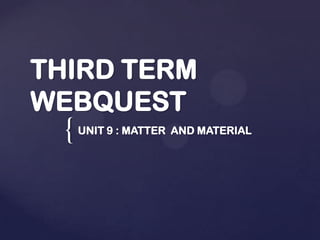Matter and materials webquest
- 1. { THIRD TERM WEBQUEST UNIT 9 : MATTER AND MATERIAL
- 2. INDEX 1. INTRODUCTION 2. PROCESS 3. ACTIVITIES AND RESOURCES ŌĆó MATTER STATES ŌĆó EXPERIMENTS ŌĆó MATERIALS ŌĆó RECYCLING 4. EVALUATION
- 3. 1. INTRODUCTION Everything has an origin. Objects that we use are made out of different kind of matter and materials. In this unit we are going to see the ways we find matter in our everyday life, characteristics of different materials and how can we save materials by recycling.
- 4. 2. PROCESS This is an individual work. 1. You need to see ŌĆ£UNIT 9: MATTER AND MATERIALSŌĆØ power point. 2. Do the activities proposed for: ŌĆó Matter states ŌĆó Materials ŌĆó Recycling 3. Send by e-mail or give to me in a paper the answers to the questions asked. 4. Ask me (in class, e-mail, blog) any questions related to the activities or contents.
- 5. 3. ACTIVITIES AND RESOURCES MATTER STATES 1. Choose 1 experiment from the experiments slides. Do it and answer the questions. 2. Do the games in these websites: ŌĆó http://www.sciencekids.co.nz/gamesactivities/gases.html ŌĆó http://www.sciencekids.co.nz/gamesactivities/statematerials.html ŌĆó http://www.sciencekids.co.nz/gamesactivities/detectivescience/statesofmatter.html 3. Make an outline about matter states and their changes.
- 6. MATTER STATES: EXPERIMENTS WATER MOLECULES ON THE MOVE You need: ŌĆó A glass with hot water ŌĆó A glass with cold water ŌĆó Food colouring Process: ŌĆó Put both glasses together on a table. ŌĆó Put one drop of colouring in both glasses. ŌĆó Watch carefully. QUESTIONS 1. Where does colorant move faster? 2. Why do you think this happens? 3. What do you have to do to change water into steam? 4. Where do molecules have more space between each other: in solids, liquids or gases? 5. Where do molecules move faster?
- 7. MATTER STATES: EXPERIMENTS MELTING CHOCOLATE You need: ŌĆó Small pieces of chocolate, all the same size. ŌĆó Paper plates. ŌĆó Paper and pencil to record your results. Process: ŌĆó Put a piece of chocolate in a paper plate in the SHADE. Record how long does it take for chocolate to melt or get soft. If it didn t melt or get soft, what happened after 10 minutes? ŌĆó Put a piece of chocolate in a paper plate in the SUN. Record how long does it take for chocolate to melt or get soft. QUESTIONS 1. Where did chocolate melt faster? How long did it take for it to melt? 2. Why does chocolate melt? 3. What happens with chocolate molecules when it melts? 4. What happens if you put the melted chocolate in the fridge? Why? 5. Where do chocolate molecules move faster? In the shade, in the sun or in the fridge?
- 8. MATTER STATES: EXPERIMENTS WATER STATES You need: ŌĆó 1 ice cube ŌĆó 1 bowl ŌĆó Paper and pen to record your results. Process: ŌĆó Put the ice in the bowl. ŌĆó Leave the ice in the kitchen and write how long does it take for the ice to melt completely. ŌĆó Leave the melted ice(water) in the bowl in the kitchen for several days. ŌĆó Record how long does it take for the water to evaporate (there is no water in the bowl) QUESTIONS 1. How long did it take for the ice to melt? 2. What happens to ice molecules when it is melting? 3. How long did it take for water to evaporate(disappear from the bowl)? 4. What happens to water molecules when it evaporates? 5. Where did the evaporated water go? What is it now?
- 9. 3. ACTIVITIES AND RESOURCES MATERIALS 1. Take 5 objects and write the materials they are made out of. 1. Classify into: ŌĆó Natural materials ŌĆó Artificial materials 2. Classify according to properties: ŌĆó Strong ŌĆó Flexible ŌĆó Elastic ŌĆó Weak 3. Do the experiment that you can find in the next slide.
- 10. EXPERIMENT: BUILDING PAPER BRIDGES Take a piece of paper and hold it between 2 boxes as a bridge. Put something on it. What happens? Now fold the paper as a paper fan and hold it between 2 boxes again. What happens now? Why do you think that happened? Try to explain what you have seen.
- 11. 3. ACTIVITIES AND RESOURCES RECYCLING 1. Do you recycle at home? What do you do to recycle? 2. Explain the three R s: ŌĆó Reduce ŌĆó Reuse ŌĆó Recycle 3. Play these games: ŌĆó http://www.sciencekids.co.nz/gamesactivities/recycling.html ŌĆó http://kids.nationalgeographic.com/kids/games/actiongames/recycle-roundup/ 4. Have a look at this website to get some ideas on recycling: ŌĆó http://www.epa.gov/recyclecity/mainmap.htm
- 12. 4. EVALUATION The last day to give in the work is: Friday 31st May 2013 The teacher will evaluate: ŌĆó Giving in the work in the set day. ŌĆó Doing all the activities proposed. ŌĆó Presentation and organization. Remember: you can send it to me by e-mail or give it to me in class. Ask me every doubt you have.











